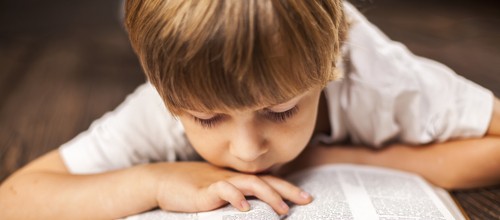Evening Prayer In the Home
Ursula O'Rourke SGS

Morning and evening are significant times for prayer in the Christian tradition. The Prayer of the Church, also known as Liturgy of the Hours, is the Church’s daily prayer. Morning and Evening Prayer are the two hinges on which the daily office turns. Hence they are to be considered as the chief hours and celebrated as such (SC 89).
Gathering in the morning, Christian people gave praise and glory to God for the gifts of creation and for the beginning of a new day. Conscious of the needs of their sisters and brothers in the world, they interceded for them in their prayer. In the evening, with the focus on the evening light and remembering Christ as the Light of the World, they gave thanks for the day, asked for forgiveness for any failings and again interceded on behalf of their brothers and sisters in the world.
At first, a very simple structure was followed: Invitation to Prayer, Hymn, Psalm 63 in the morning and Psalm 141 in the evening, Scripture and Intercessions. However over the centuries, the prayer became the preserve of monks and nuns, and then also of the ordained clergy. It was no longer central to the prayer life of the whole Christian community. The faithful turned to a more devotional style of prayer – the rosary, novenas and prayers in honour of the saints.
One of the key principles that governed the revision of the Prayer of the Church after Vatican II was that the people of God should again be able to participate fruitfully in praying the prayer…Pastors should see to it that the chief hours, especially Evening Prayer, are celebrated in common in church on Sundays and the more solemn feasts… the laity are encouraged to recite the divine office with their priests, or among themselves, or even individually… (SC 100).
This recommendation of the Council was a positive step toward the integration of the whole people of God into the public prayer life of the Church. Indeed it is the duty of the whole Christian community to continue Christ’s priestly prayer, which is what we do in the Liturgy of the Hours. It belongs to the whole body of the Church and it expresses the very essence of the Church as a praying community.
However, fifty years after the Second Vatican Council, we have made little progress in actually drawing people into this ancient tradition of praying daily the priestly prayer of Christ. What is the way forward? We thought that one step towards this implementation would be to provide a simple model by which the family as the domestic Church might experience the prayer.
Evening Prayer in the Home is intended to link the family to the Church’s tradition of praying at this significant moment of the day. Often the evening – rather than the frenetic morning – offers the space and quiet for praying together. It could become a daily or weekly (Sunday) pattern of family prayer in our busy lives, perhaps before or after the evening meal.
It is intended to be more or less fixed so that children and adults will virtually come to know it by heart. Older children can take the role of leader. Everyone can learn to sing the hymn and canticle together. The symbolic actions of lighting a candle and an incense stick move the prayer beyond mere words. The shared intercessions will help members of the family to name their own concerns in prayer. Keep it simple.
And perhaps when this prayer is known and loved in the family, we might see again a flourishing tradition of Morning and Evening Prayer as the daily prayer of the whole Church.
This article was originally published in Liturgy News Vol 42(4) December 2012. Reprinted with permission.
